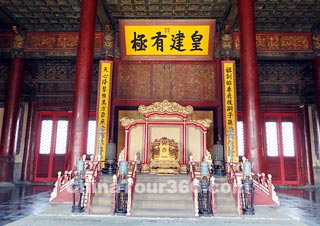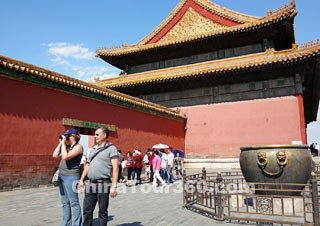Baohedian, Hall of Preserved Harmony, is one of the three major halls in the outer court of the Forbidden City, and the other two are Hall of Supreme Harmony (Taihedian) and Hall of Central Harmony (Zhonghedian). The Hall of Preserved Harmony is located at the north end, the last of the three halls. Having fewer golden pillars than the other halls in the Forbidden City, it feels more spacious and comfortable.
|
|
The Hall of Preserved Harmony served different purposes in the Ming and Qing dynasties. In the Ming Dynasty (1368 - 1644), it was a place for the emperors to change clothes before ceremonies and to receive the congratulations from courtiers when conferring an empress or a crown prince. In the Qing Dynasty (1644 - 1911), it was the place for the emperors to bestow banquets on kings of the subsidiary states, princes and dukes, as well as the high-rank ministers on New Year’s Eve and Lantern Festival.
In 1789, the Hall of Preserved Harmony replaced the Hall of Supreme Harmony, to become the examination hall for the final imperial exam. There are four levels for the ancient Chinese imperial exam - academic exam, provincial exam, metropolitan exam and final imperial exam. Only when one passed the first three exams could he enter the final imperial exam which was held every three years. The content of the final imperial exam was decided by the emperor who would also exam the papers of the top ten. Those who passed the final imperial exam would be qualified to be high officials.
There are also many noteworthy scenic spots outside the Hall of Preserved Harmony. Among these the most outstanding is a stone carving of dragons and clouds. It is actually an imperial road stone carved with patterns of clouds, dragons, seawater and cliff, and is located between the steps to the back door of the Hall of Preserved Harmony. Regarded as the largest stone carving in the Forbidden City, it is 16.57 meters (18 yards) long, 3.07 meters (3.4 yards) wide and 1.7 meters (6 feet) thick, weighing 250 tons (551 pounds). It was originally carved in the Ming Dynasty and re-carved in the reign of Emperor Qianlong in the Qing Dynasty. It pictures nine dragons playing with pearls among the cliff, sea and clouds, very dynamic and vivid. The most amazing thing about is that it was carved out of a single stone, This means that even a small mistake would have destroyed the whole work. There is no doubt that it was difficult to carve, but the even bigger problem was transporting such a huge stone to Beijing from Fangshan District. It said that it took nearly one month and cost a great amount of labor to transport the stone.
![]() Go to the Next Attractions: Gate of Heavenly Purity & Office of Grand Council
Go to the Next Attractions: Gate of Heavenly Purity & Office of Grand Council










